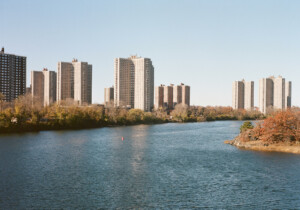The Regional Plan Association has released a new study on housing affordability and its notoriously difficult-to-measure twin, displacement. Although displacement is often reported as individual battles over affordable housing or new development in neighborhoods like East New York and East Harlem, Pushed Out: Housing Displacement in an Unaffordable Region (PDF) illustrates the widespread impact of displacement in the tristate area, from Northern New Jersey up to New Haven, Connecticut.
Despite good intentions, urban planning often reflects the priorities of four decades ago, when cities confronted deficits, white flight, deindustrialization, and the collateral damage of urban renewal. Now, data shows that throughout New York metropolitan area, wealthier (and whiter) people are replacing people of color in dense, central city neighborhoods with good transit access. There are, the RPA estimates, 990,000 people in the region who are at-risk of displacement; more than two-thirds of this group are Black or Latino.
To ease the rising cost of housing and keep low-income residents in place, Pushed Out proposes policies like deeper rental subsidies, broader affordability ranges, centering displacement risk into land-use, and more legal protections for tenants, especially around eviction prevention and in areas outside of New York City where rent protections are weak or non-existent. This most recent report, which includes interviews with those affected directly by displacement, will be part of the RPA’s fourth regional plan, due out later this year.
In conjunction with the release, RPA held a morning forum at the Ford Foundation where two panels of community leaders and city officials from the region gathered with an audience of their peers and neighbors to discuss strategies for resisting displacement and advocating for longtime residents in the face of change.
Maria Torres-Springer, the new head of NYC Housing Preservation and Development (HPD), joined Dina Levy, deputy director of community impact and innovation in Attorney General Eric Schneiderman’s office; and Jersey City Deputy Mayor Marcos Vigil for a panel discussion on what municipalities can do to combat displacement (NY1’s Errol Louis moderated). HPD, Torres-Springer noted, is beginning to experiment with community land trusts, while Vigil said Jersey City, in response to an influx of 50,000 new residents, offers incentives to developers who build housing outside of transit-rich, wealthy neighborhoods.
The solutions are meant in part to address an acute displacement trend: RPA’s report found that desirable, central city neighborhoods have seen a two percent decrease in households earning less than $100,000 annually, while these same areas have accommodated 11 percent more households earning $100,000 annually. The group mused on the difficulty of providing truly affordable housing when, for example, federal agencies set standards of affordability that may not align with local needs. “There’s a legal definition of affordability,” said Vigil, “but really it means a good, safe place to live.” Panelists were on the lookout for instances in which public policy accelerates displacement, but given their institutional roles and the short timeframe, discussion trended towards optimism and broad tactics.
Barika Williams, deputy director of the Association for Neighborhood and Housing Development, moderated a second panel on how displacement risk is experienced on the ground. Executive Director of Community Voices Heard Afua Atta-Mensah; NYU Furman Center Director Ingrid Gould Ellen; Raymond Ocasio, executive director of La Casa de Don Pedro; and New York City Council Member Antonio Reynoso spoke about how the rising cost of housing is putting pressure on the (mostly) low-income communities of color they advocate for and represent. Reynoso, whose district includes parts of Williamsburg, Bushwick, and Ridgewood, spoke passionately about housing pressures facing his constituents: “Law, policy, and safeguards are being outpaced by development,” he said. “Do we have the resources and will to sustain the preservation of affordable housing and build more housing to combat the erosion?”
As poorer residents are pushed to the city limits and the suburbs, panelists agreed that planning needs to extend beyond town lines. “It’s better,”Atta-Mensah said, “to get in at the front end and talk about this regionally.”










